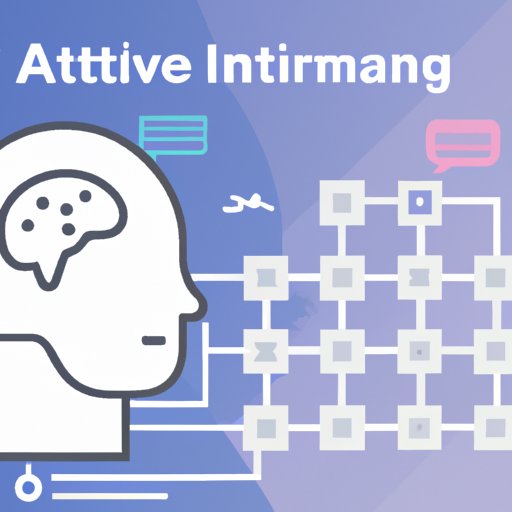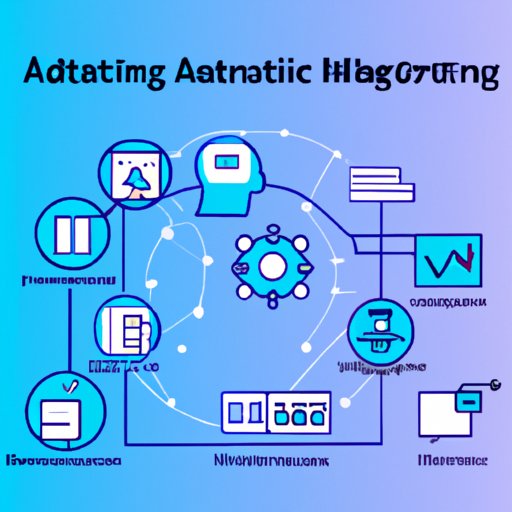Introduction
Artificial Intelligence (AI) is a rapidly growing field with many potential applications in various industries. By leveraging machine learning algorithms, AI can be used to automate mundane tasks and make decisions faster and more accurately than humans. The potential benefits of implementing AI are numerous, including increased efficiency, cost savings, and improved customer service.
This article will discuss the process of implementing AI, from developing a comprehensive strategy to creating and validating an AI algorithm. We’ll cover the key considerations for each step and provide tips on how to ensure success in the implementation process.

Develop a Comprehensive AI Strategy
Before you start the implementation process, it’s important to develop a comprehensive AI strategy. This strategy should include your business objectives and identify areas where AI can be used to improve performance. It should also outline the resources required to achieve these objectives and set out a timeline for implementation.
To create an effective AI strategy, you need to define your business objectives. Ask yourself: What are the goals that you want to achieve? What problems do you want to solve with AI? Once you have identified your objectives, you can begin to analyze existing data sets and identify areas where AI can be used to improve performance.
Once you have identified the areas where AI can be used, you should then create a plan for implementation. This plan should include the resources required, a timeline for implementation, and a budget for the project. You should also consider any potential risks and challenges that may arise and how they can be addressed.
Design an AI Architecture
Now that you have developed a comprehensive AI strategy, it’s time to design the AI architecture. This architecture should take into account the specific needs of your project and the resources available. It should also include the appropriate hardware and software for the task at hand.
When designing the AI architecture, you should select the most suitable architecture for your project. This could be a deep neural network, a convolutional neural network, or a recurrent neural network. Each has its own advantages and disadvantages, so it’s important to choose the one that best meets your requirements.
Once you have selected the architecture, you should determine the hardware and software required for implementation. This includes the type of processor, memory, and storage needed, as well as the programming language and development environment. You should also develop a plan for implementation, which should include a timeline and budget.

Collect and Organize Data for AI
The next step in the implementation process is to collect and organize data for AI. This involves identifying sources of data, cleaning and pre-processing the data, and storing it in an organized manner.
First, you need to identify the sources of data that you will use for your project. This could include web scraping, public datasets, or proprietary data sources. Once you have identified the data sources, you should then clean and pre-process the data. This involves removing any extraneous information, formatting the data, and ensuring that it is in a suitable format for analysis.
Finally, you should store the data in an organized manner. This could involve using a database or a cloud storage solution. It’s important to store the data in a way that makes it easy to access and analyze when needed.
Create the AI Algorithm
Once the data is collected and organized, it’s time to create the AI algorithm. This involves selecting an AI algorithm that is suitable for your project and training and refining the model. You should also optimize the algorithm for accuracy and speed.
When selecting an AI algorithm, you should consider the type of data you are working with and the task that you want to accomplish. There are many different algorithms available, such as supervised learning, unsupervised learning, reinforcement learning, and transfer learning. You should choose the one that best meets your requirements.
Once you have selected an algorithm, you should then train and refine the model. This involves feeding the algorithm with data and adjusting the parameters to get the desired results. You should also optimize the algorithm for accuracy and speed. This involves testing different parameters and configurations to find the optimal settings.

Test and Validate the AI Algorithm
Once the algorithm is trained and refined, it’s time to test and validate it. This involves setting up test cases and running tests to ensure that the algorithm performs as expected. You should also analyze the results to identify any issues that need to be addressed.
When setting up test cases, you should create scenarios that simulate real-world conditions. This will help you identify any potential issues and ensure that the algorithm performs as expected. You should also run tests regularly to ensure that the algorithm continues to perform optimally.
Monitor and Maintain the AI System
Finally, you should monitor and maintain the AI system. This involves establishing performance metrics, monitoring system performance, and updating algorithms as needed. This is important to ensure that the system continues to operate as expected and that any issues are addressed quickly.
To monitor system performance, you should establish performance metrics. These metrics should measure the accuracy and speed of the algorithm, as well as any other relevant factors. You should also monitor the system regularly and update the algorithm as needed to ensure that it is performing optimally.
Conclusion
Implementing AI can bring many benefits to businesses, including increased efficiency, cost savings, and improved customer service. However, it is important to follow a systematic approach when implementing AI, from developing a comprehensive strategy to creating and validating an AI algorithm. Following these steps will help ensure that the implementation is successful and that the desired outcomes are achieved.
(Note: Is this article not meeting your expectations? Do you have knowledge or insights to share? Unlock new opportunities and expand your reach by joining our authors team. Click Registration to join us and share your expertise with our readers.)
